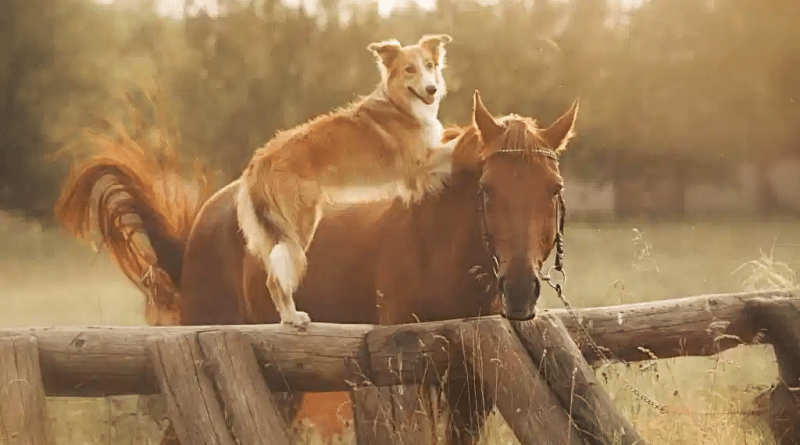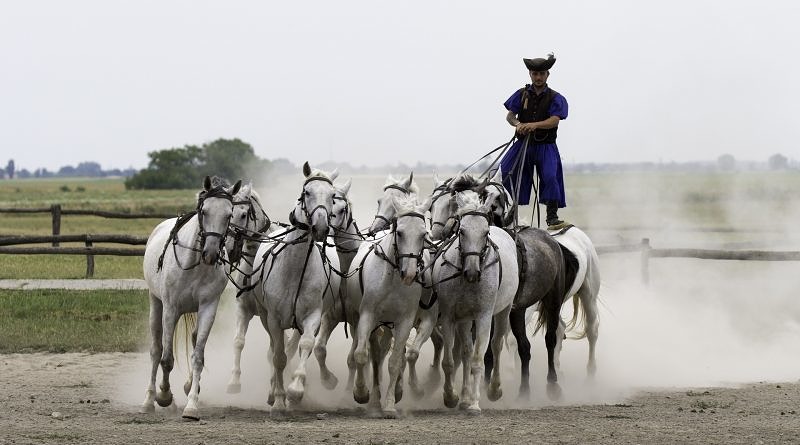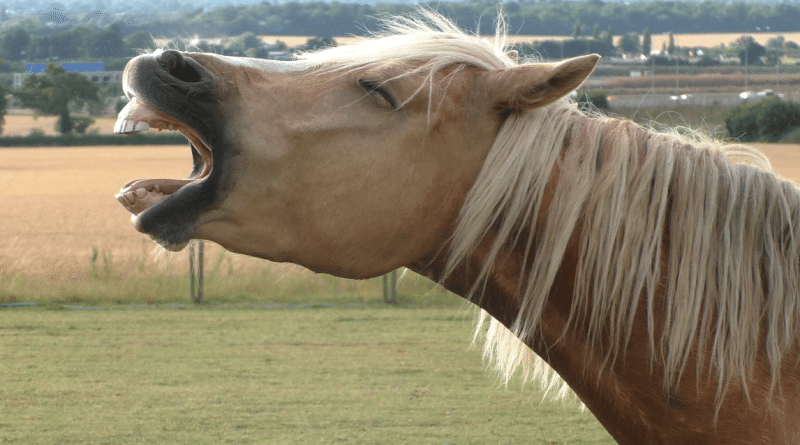5 Tips to Keep Your Dogs Safe Around Horses (and vice versa!)
Do you share your life with both horses and dogs? Here are a few tips that will keep your companions safe when they meet!
Dogs and horses don’t always get along, and this can be a problem for many equestrians who are often also dog owners! Both species are wonderful companions that we love, but they can pose a danger to one another, especially if either animal becomes spooked or anxious.
If your dog has never seen a horse before, or vice versa, the outcome of an encounter could be unpredictable. It is a good idea to take some precautions to ensure that your dogs and horses are safe, and teach them to coexist with one another in a peaceful manner.
Socialisation (Introductions)
If you want your dog to learn to be around horses, you of course need to introduce them to the barn environment and to horses. However, introductions between horses and dogs need to be made gradually. First your dog needs to become familiar with the sights, smells, and animals without being too overstimulated. You can start by simply taking your dog to the barn for a short period and walking them around the area.
When your dog is used to the environment, you may decide to introduce the animals to one another. This is an important time to try to create positive associations for both animals. Start by letting the dog and horse see each other from a safe distance so that you can see how they are feeling and reacting. Over time you can close the gap between them, but only as you see that both animals remain relaxed and are not concerned about each other. Pay close attention to subtle cues from both as these are easily overlooked.
If both animals are comfortable, you may want to allow them to investigate each other with a barrier between them for safety, such as a fence. At this stage you do not want to overstimulate either animal – just keep things as calm and relaxed as possible. Talk calmly and quietly as dogs can become excited and reactive easily.
Get your animals used to one another by creating a routine around your visits. This will make their interactions with each other predictable and reduce stress on both. Ideally, your dog and horse will look forward to seeing each other and not fear their encounters.
Always Take Safety Precautions
It is important to accept that no matter how much effort you put into introducing your dog to your horse, there is always a chance that they will never truly get on or be happy in each others’ company. Unlike us, horses do not necessarily see dogs as companions and can easily decide that a dog is a threat. Equally, some dogs are not comfortable around horses or may want to play or interact with them in a way that is not safe or fair to the horse.
It is therefore always a good idea to have a back-up plan. A dog leash or crate are simple ways to create space between your dog and horse and keep both safe in an emergency. Of course ensure that you properly leash and crate train your dog so that this doesn’t have to be a stressful experience. This is something that needs to be started outside the barn environment. Consult a professional trainer if you need help!
As well as being a good way to keep your animals separated in case of emergencies, a crate can also keep your dog contained for short periods when you want to be fully focused on your horse. For instance it may be a good idea to contain your dog while grooming or handling your horse where you may not be able to closely monitor your dog or where what you are doing could cause the dog to want to investigate or come closer than the horse would like. “Any situation where you are not able to keep a close eye on your animals is a good time to have some way of containing them. It is all too easy for your dog to wander around a horse unnoticed and accidentally succumb to injury,” warn the veterinary experts at Bond Vet.
Train Your Dog to Recognise Commands
If you want to ride with your dog nearby or off-leash, you should have a well-trained dog who will listen to your commands no matter the distraction. Some of the most basic commands to train your dog would be to ‘sit’, ‘stay’, ‘leave it’, and ‘lay down’.
You need to have these commands firmly ingrained in your dog’s mind, so that if a problem happens to arise, you can quickly ensure you have control over the situation. Of course your horse can also learn to respond to cues and some cues may be useful in an emergency, such as having a solid ‘stand’ or ‘whoa’. Remember that both your dog and your horse will respond to your reactions in a high-stress situation so keeping calm and being prepared is essential.
To achieve this, you should practice obedience training in other distracting contexts. You can even enlist the help of someone else to ride your horse and practice training your dog nearby. See if your dog is able to pay attention to you despite everything else that may be going on! If your dog struggles with this, as many do, start your training in a place with no distractions and gradually work up to other situations and being near your horse.
Understand Body Language
One of the best things you can equip yourself with is an understanding of horse and dog body language. There are many indicators of when your dog is happy, subdued, alert, fearful, or on the defense.
If your dog has flattened ears, is crouching, or tucking its tail between its legs, it most likely is afraid and most people are able to recognise these signs. Many dogs will also become defensive and may growl and bark when they are unhappy or nervous. However other signs are more subtle such as excessive lip-licking, so-called ‘whale eyes’, or even avoidance gestures like looking away. Familiarising yourself with calming signals is a good way to become better at reading your dog so you can act before things go wrong.
Horses will show some very obvious signs of fear – such as physical tension or unwillingness to stand still. However, they also display many much more subtle signs of concern long before their flight response kicks in. Again, learning about horse body language and calming signals is a great way to avoid problems and to become better at predicting what your horse might do in any situation. A lot of horse owners think they already know what their horse’s body language is saying but in reality there are a lot of misconceptions surrounding this and it is easy to misinterpret behaviour.
If you see that either your horse or dog are becoming concerned about each other, you should quickly create some distance between the animals while staying calm so as not to contribute to their stress.
Stay in Control
When you are working with either animal, the most crucial tip is to control the circumstances under which your dog and horse encounter each other. Things can escalate quickly, and you especially want to avoid any type of chase situation. Keeping your horses and dogs separated in enclosed areas is ultimately one of the best ways to keep both animals safe at all times. The most important thing is to appreciate that your animals are individuals and there is no guarantee that they will ever get along. That is ok!
However, by providing suitable training for each animal and being as prepared as you can to defuse tricky situations, you can set them up for success. The more you expose your horse and dog to each other in a positive and controlled manner, the more likely it is that they will become used to one another and will be able to coexist peacefully. In some lucky cases dogs and horses can even enjoy each others’ company and become friends!
Nicole McCray is the alias behind PuppySmarts.com and is a prolific writer on a variety of animal topics. She is a dog lover and owner of two wonderful rescue dogs, and grew up helping run her parents’ boarding facility before becoming a vet tech.







